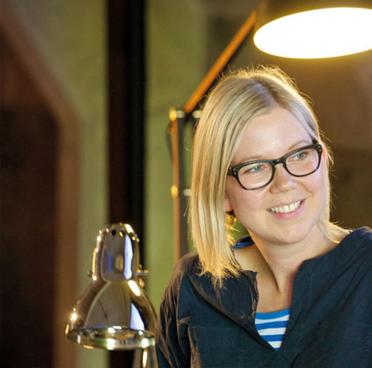The Invisible Store of Happiness: Designing
Laura Ellen Bacon is a sculptor. Sebastian Cox is a furniture designer. Laura sketches in 6B pencil. Sebastian uses a 2H, or a computer. For Laura, the form and scale of a piece dictate the material. Sebastian designs objects that make best use of his material. Laura’s creative process starts with the space she’s designing for. Sebastian rarely knows where his work will end up. Laura works with her hands, often using willow because of how it feels in her fingers. Sebastian uses machines, and even when he’s making by hand there’s a tool between his hands and the wood.
What these two very different designers do have in common is a love of wood, and a love of making. “Every maker derives such a lot of joy from the making process,” says Laura. “That shows in your work – it has a fullness to it. Everything you make has an invisible store of happiness hidden inside it. We poured over ideas for months, but in the end that’s what it came down to.” So the seed for the Invisible Store of Happiness was sown.
Working together to turn that seed of an idea into three-dimensional form has tested them, challenged them, driven them. But the design process has always come back to a love of making things out of wood. Together, they have been able to look at American hardwood in a completely new way.
“To work with Laura, I needed to reduce the material from great lumps of hardwood to something that could be woven,” said Sebastian. “The obvious way would have been to cut it into strips, but I wanted to do something more interesting, more efficient, more beautiful.” Using a spindle-moulder and a series of cutters, straight lengths of maple are partially split into ribbons, which are then soaked in water overnight creating something more akin to the willow Laura is used to working with. “Kiln dried American hardwood is usually used for flooring or furniture, it’s a very solid thing, so we’re reimagining how it can be used,” says Sebastian.
And that’s not all they’re planning to do with it. “We want fluidity in parts and solidity in others,” says Laura. “We want some sort of disciplined structure in there. It will be clearly defined and show strength and yet also have this organic aspect to it.”
But for all their talk, the honest truth is that they don’t yet know what it will be. There are sketches (Laura), CAD renderings (Sebastian) and 1:1 plywood models, but until the wood comes off the boat from America, they simply don’t know what they’ll have to work with. “We still don’t know what’s going to arrive in that container, which is quite exciting,” says Sebastian, “We have to design this thing to make sure it will work with whatever lengths, whatever grades of timber arrive. And that is an important point. Of all the wood that grows in the forest, you can’t only take the sweet stuff – you’ve got to use some sap wood, some shorter lengths, some not so straight bits.”
What is very clear is their vision: “As you approach it, it will feel very constructed, very ‘made’, almost architectural,” says Laura. “But as you go past it, you’ll get tantalising glimpses of the interior. Inside, gorgeous surges of organic wood will feel like they’re springing from the structure. It will be deeply textural, like standing in seaweed in a flowing river. You will get the chance to just stand for a moment and breathe it in.”
I for one can’t wait.
